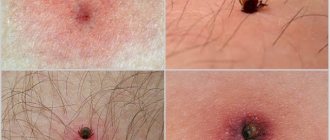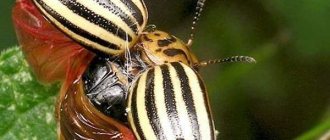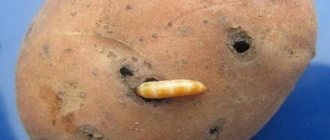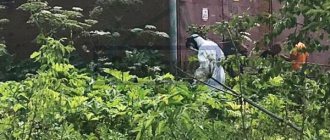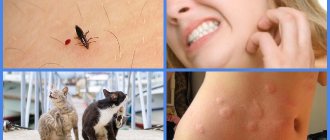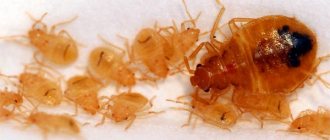Worms in fish that are safe for humans
Finding parasites is often an unpleasant and unappetizing moment. But not all fish worms are dangerous to humans.
The following species do not pose a threat to human health:
- Flatworms (diplostomas);
- Roundworms (polymeters);
- Tapeworms (several types).
Diplostomy
The main places for parasitism of this worm are the eyes, gill compartments, and the area of the pectoral fins. A certain type of this worm lives exclusively in the eyes of fish, as a result of which the fish notices clouding of the eyes and loss of vision in the future.
This type of worm is found in fish that live in fresh water; the families of perch and carp fish are mainly affected, most often perch and roach.
This parasite is white in color, can reach 70-80 cm in length, and has a flat appearance, similar to flat homemade noodles.
Pilometra
The habitat of this parasite is quite far away, in the southern parts of the Pacific Ocean. However, in the CIS countries there have been cases of detection of this worm in imported fish.
It occurs in individuals depending on gender. In females, the worm lives in scaly pockets, and in males, inside the swim bladder. Fish of the carp family are susceptible to this parasite.
The parasite is red in appearance and can be about 10 cm long. Properly cleaned fish can be eaten. For better insurance, fish in which this type of worm is found is fried; heat treatment completely neutralizes these parasites.
Tapeworms
Ligula intestinalis is a tapeworm. One of the longest parasites present in fish, the average individual reaches a length of 100 centimeters.
The Ligulidae, just like the common Ligulidae, conducts a similar lifestyle in the body of aquatic inhabitants. It differs only in size, it parasitizes small individuals, the length of the worm is 3-5 cm.
Main carriers of parasites
The above-described fish worms provoke the development of the following diseases:
Anisakidosis
Anisakid larvae, entering the human body, cause:
- severe allergic reaction;
- diarrhea;
- painful sensations in the abdomen;
- intestinal inflammation and peptic ulcer.
Consequences of the disease:
- intestinal obstruction;
- perforation of the intestinal walls;
- peritonitis.
The carriers of anisakid parasite larvae are the families of cold-blooded animals:
- cod (hake, pollock, Atlantic cod, Pacific cod, haddock, pollock, whiting);
- salmon (pink salmon, Atlantic salmon, trout, chum salmon, sockeye salmon, taimen, smelt, capelin);
- perch (Volga pike perch, ruff, river perch);
- mackerel (common, bluefin, mackerel, mackerel);
- herring (herring, Atlantic herring).
Metagonimiasis
The disease develops when a person is infected with Metagonimus.
It makes itself felt by the manifestation of symptoms such as:
- fever;
- body rash;
- diarrhea;
- painful sensations in the abdomen.
A helminthic infestation can also be asymptomatic.
The carriers of Metagonimus larvae are fish of the following families:
- carp (common carp, bream, redeye, gudgeon, crucian carp, silver carp);
- salmon (whitefish, pollock).
Nanophyetosis
This diagnosis is made when infected with nanophyetus. These fish parasites cause persistent diarrhea with signs of intoxication - nausea, vomiting. Due to dehydration and exhaustion of the body, the patient develops anemia.
The main carriers of nanophyetus parasite larvae are the following families:
- salmon (chum salmon, Dolly Varden, Siberian grayling, lenok, taimen, whitefish, kunja);
- cyprinids (minnow, dace, leopard);
- pike (common pike, Amur pike).
Opisthorchiasis
The disease is caused by the Siberian fluke parasite.
Its larvae are most often found in fish of the following families:
- carp (common carp, bream, tench, redeye, dace, podust, roach);
- salmon (pollock, chum salmon, kunja).
Infection with the Siberian fluke is characterized by damage to the gallbladder, pancreas and liver.
Complications of helminthic infestation:
- hepatitis;
- cholecystitis;
- peritonitis;
- gastrointestinal oncology.
Worms in fish that are dangerous to humans
Do not forget that only a small percentage of parasites found in fish are not dangerous to humans. Eating raw or semi-raw foods can lead to serious complications.
Parasites found in both freshwater and sea fish that are dangerous to the body:
- Clonorchis;
- Anisakids;
- Opisthorchis;
- Diphylobothrium.
Clonorchis and opisthorchis
They belong to the order of flatworms (trimatodes), the main habitats of this parasite are mollusks. Among river inhabitants it is found in the carp family (carp, roach, bream, carp, etc.).
Smaller individuals of this parasite also live in small fish; subsequently they can be found in animals and birds that have consumed infected meat.
Parasites of the subspecies of trimatodes perform the function of flukes, sticking to the walls of the stomach of fish, animals or birds, which leads to further death of parts of the stomach and tissue necrosis in general.
Trimatodes are predominantly red in color and reach a length of 10 cm (large worm) and 2-3 cm (small parasite).
Anisakids
The most harmful parasites living in fish. They are considered the most dangerous worms for the human body due to their transient parasitism.
Anisakids are divided into two types:
- Anisakissimplex
- Pseudoterranova
Anisakissimplex – better known as the herring worm, is primarily found in pollock, mackerel and herring.
Pseudoterranova - cod worms, differ from the first species in smaller size and are found exclusively in cod. This type of parasite is resistant to low temperatures; even living specimens of this worm were found in a frozen carcass. The site of parasitism is predominantly the liver.
They enter the human body through consumption of improperly prepared, raw or lightly salted fish.
Diphyllobothrium
There are 3 types of cestodes that can infect the human body:
- Latum;
- Dendriticum;
- Nihonkiense.
The most dangerous latum is better known as the broad tapeworm. It is one of the longest worm-like parasites. The length of the parasite reaches 10 meters, life expectancy is 20 years.
The parasite grows by changing its owner. The first habitat of the tapeworm larvae are crustaceans or small individuals, then the maturation of the parasite individual can occur together with the maturation and growth of its inhabitant, or when the host eats larger fish.
Even in a large fish, the parasite may be in the larval stage and when it is cut, the parasite may not be noticed. Therefore, it is not recommended to eat raw or semi-raw fish.
What diseases are caused by worms in fish?
Many consider fish meat to be the safest food product than the meat of birds and mammals, due to single outbreaks of bird and swine flu.
Unfortunately, even eating fish can infect the human body, if not fatally, then with a very serious illness.
Diseases associated with eating fish meat with parasites include:
- Diphylobothriasis;
- Opisthorchiasis;
- Anisakidosis;
- Clonorchiasis;
- Metagominosis;
- Heterophyosis.
Anisakidosis
Herring and cod worms, as well as pollock worms, prefer to parasitize in the fish body, but in the human body they linger for a short time and try to get out.
Despite their short stay in the human body, worms can cause significant harm to the body.
The presence of this parasite in the body is indicated by the following symptoms:
- Nausea;
- Vomit;
- Weakness;
- Heat;
- Diarrhea;
- Flatulence;
- Pain in the pancreas or stomach;
- Allergic reaction (hives, swelling of the eyes, face, etc.)
Diphylobothriasis
The causative agent of diphylbothriasis is the broad tapeworm. Unlike the previous parasite, the tapeworm is well adapted to living in the human body. The lifespan of a tapeworm in the human body is about 10–15 years, while the length of the parasite reaches 12 meters.
This disease is very asymptomatic; the carrier may not be aware of the presence of the parasite. Moreover, such rare symptoms as abdominal pain, frequent diarrhea, nausea and belching are considered to be the consumption of junk food.
Also present in the symptoms of diphylbothriasis are:
- Drowsiness;
- Loss of taste or strange aftertaste;
- Allergic rashes or hives;
- Weight loss;
- Vomit;
- Loss of appetite.
Note! Diphylobothriasis in advanced stages leads to atrophy of the pancreas.
Clonorchiasis and opisthorchiasis
These two diseases are similar in their symptoms, so opisthorchiasis is often classified as clonorchiasis. The causative agent is the parasites clonorchis or Chinese flukes, which are classified as liver flukes.
The habitat of these worms is the stomach and liver. The carrier of this parasite has a high chance of developing jaundice, pancreatitis, hepatitis, which can subsequently develop into cirrhosis of the liver.
The symptoms of the presence of the parasite are quite extensive:
- Temperature rise;
- Yellowing of the whites of the eyes;
- Inflammation of the lymph nodes;
- Pain in the liver;
- Diarrhea;
- Overexcitation or state of inhibition;
- Lack of sleep.
Heterophyosis and metagonimiasis
The worm is localized in the human intestine; the eggs of the parasite can reach the brain through the bloodstream. The chronic course of the disease is caused by prolonged diarrhea, salivation, and pain in the abdomen. Heterophyosis is also a causative agent of enteritis. Metagonimiasis is characterized by a stable temperature of 38-39°C.
Symptoms of heterophyosis are:
- Stomach upset (diarrhea or constipation);
- Allergic reactions;
- Migraine;
- Nausea and vomiting.
What do worms look like in pollock?
Considering the diversity of helminths, they are divided into three groups, which include round parasites (nematodes), flat flukes and tapeworms (cestodes). Their external data differs due to the nature of their life activities. A description of the main types of worms living in pollock will help to correctly determine their identity and danger to humans.
Acanthocephalans of the genus Echinorhynchus
These parasites belong to the spiny-headed worm family. They can often be seen on the surface of the body of fish and can reach 8 cm in length. The color of worms ranges from bright orange to red, which makes them easy to distinguish against a light background.
Acanthocephalans of the genus Echinorhynchus
When pollock swims in water, acanthocephalans parasitize its intestines; after being caught, they quickly migrate to the skin and scaly integument. The body of helminths has a characteristic ringing and looks like it is segmented, which is false. In fact, it is a solid parasite with a proboscis framed by hooks at the front end, which helps to anchor itself in the intestines and can be retracted into the body if necessary.
Nibelinia
Pollock with worms of this species are often imported from the Sea of Okhotsk. Worms belong to the type of cestodes and parasitize in the internal organs of fish; the larvae often penetrate the muscles and membranes of the gastric and intestinal tract. The dimensions of Nibelinia are tiny - no more than 6 mm, the body is flat, slightly elongated.
In an enlarged photo of worms in pollock, these parasites look like a lump attached to the anus at the back. Upon careful examination of the muscles of the pollock, you can see the larvae of Nibelinia, which are no more than 3 mm in diameter.
Examination of the fillet helps to suspect the presence of helminths of the genus Nibelinium in the carcass. It has transverse breaks and becomes shapeless and loose.
Nibelinia and pyramidicocephalus
Pyramicocephals
These worms in pollock are localized in the intestines, muscle fibers and liver. The parasite is called the seal pyramicocephalus or Diphyllobothrium cestode. It is a type of tapeworm and can have a body length from a few mm to a meter. The structure provides for the presence of a helminth head, neck and strobila, which in turn consists of many segments. On the head, devices in the form of suction cups and hooks are clearly visible.
Aprocotyle pollock
This is a trematode of the Aporocotyle theragrae class, up to 7 mm long and up to 2 mm wide. The parasite has a body narrowed at both ends, is not equipped with suckers and parasitizes in the vessels of the gills and heart, as well as in the lymphatic system. Aprocotyle larvae penetrate pollock through the skin. In his body, the parasites turn into mature yellow worms. If you buy a carcass without a head and entrails, you often cannot see the worms, but they sometimes get into the cavity of the pollock when cutting.
Aprocotyle pollock (trematode) and spirurid nematodes
Spirurid nematodes
These parasites in pollock are represented mainly by the larvae of spirurid roundworms. Helminths have a thin spindle-shaped body up to 10 mm long and no more than 0.1 mm wide. In the tail part of the worm there are two papillae, and on the head there are pseudolips with pointed ends. Nematodes parasitize in the internal organs of pollock and in its pyloric folds.
Anisakids
The variety of these worms in pollock can be considered the most common. Fish are parasitized by the larvae of these nematodes, both not dangerous to humans and posing a health threat. Anisakis attacks the intestines, muscles and internal organs of pollock. The worm larvae are curled into a round spiral and protected by a transparent capsule. If the nematode is removed, it reaches 2.5 cm in size. It looks like a small worm with a needle-like body, the color can be from milky to reddish.
The larvae inside the carcass can be seen with the naked eye; they are usually attached to the insides or walls of the abdomen. Eating pollock with this type of worms is quite dangerous, even after washing the carcass. If the worms are localized in the muscles, which can be checked by viewing it in the light, then it is better to throw away the product. Living anisakids are dangerous to humans. When ingested, they penetrate the stomach, intestines, pharynx and pancreas, causing infectious sepsis.
Anisakids and cod worm
cod worm
The worm freely parasitizes the body of pollock, penetrating the muscles, stomach and intestines. In appearance, it is a reddish-brown helminth up to 6 cm long. When cutting up a carcass, many housewives mistake it for blood veins and are not aware of the danger. Infection with these worms in humans is easier than anisakiasis. Clinical symptoms include periodic acute abdominal pain and general malaise. The cod worm can penetrate the human larynx and the gastric mucosa.
How to distinguish infected fish?
In order to distinguish infected fish from healthy ones, when cutting a carcass you need to carefully examine its gills, entrails, etc. Particular attention should be paid to the tissues in the meat, the main habitat of parasites.
It is also worth examining the abdominal walls; black spots indicate the presence of parasitic worms; adult individuals can be detected with the naked eye, which indicates infection.
Let's celebrate! Also, when fishing, you can notice if the fish stays on the surface, behaves quite passively when retrieving or biting - this is the first sign of an unhealthy condition.
If a caught fish has a swollen belly, this 90% indicates a rather advanced process of parasitism.
What to do if worms are found in fish?
If there are worms, it is better not to eat meat at all.
But if you are still going to eat fish meat and there is a suspicion that it is infected, then there are several rules that will help you not to become infected yourself:
- Fry or boil meat for at least 20-25 minutes, since heat exposure kills worms and their larvae;
- Bake for more than 30 minutes;
- Salted fish should be eaten 25-30 days after salting; parasites in salted fish die after 2.5 weeks;
- When fish is frozen at -30 °C, the worms die after 6 hours, at -20 °C death occurs within 1.5 days, and at -12 °C after 2.5 days.
How to prevent infection
There are special prevention methods that help stop the penetration of worms into the human body. If you follow all the recommendations, you will be able to reduce the infection to zero.
- One of the important points of the measures is washing your hands with soap. If this is not possible, then you can use damp antibacterial wipes. The procedure is recommended to be carried out before meals and upon returning home.
- When an animal lives in a living space, it is necessary to increase the number and quality of wet cleaning.
- Wash your hands after contact with your pet.
- Do not drink water from rivers, ponds and other places.
- Use only well-washed products.
- When relaxing in nature, use insect bite repellents.
- When consuming raw fish, first freeze it at least -35 degrees. Leave for 15 hours.
- Heat treatment of fish should be above 60 degrees, lasting more than 30 minutes.
- There is no need to buy fish from dubious sellers and private traders.
- Do not eat lightly salted or raw. Take only hot smoked specimens for food.
- Also carry out deworming for preventive purposes.
Using the above information about the types of worms and their harm, you can protect yourself from serious diseases. It is better to refuse the dish than for a person to get parasites from the fish and rather than waste time on treatment.
Which fish doesn't have worms?
You should purchase fish products exclusively from trusted stores, where, if necessary, you can be provided with a certificate of product inspection and compliance with sanitary standards.
Avoid eating dishes with raw or lightly salted fish. When preparing fish, it is important to follow all technical rules and carefully inspect the carcass when purchasing it.
Let's celebrate! You should always be on guard when eating fish dishes.
And if parasites are detected, for better health prevention, it would be wise to refuse such fish.


